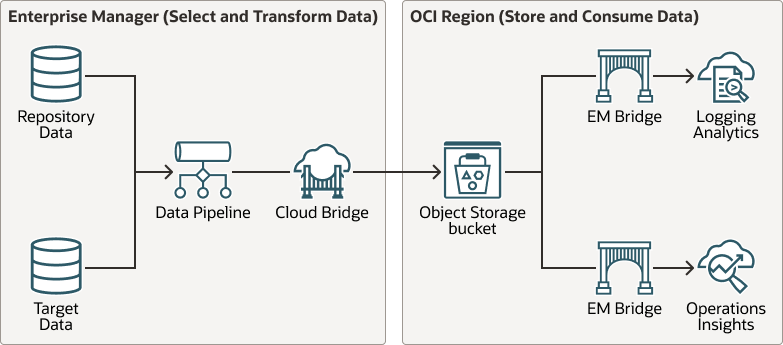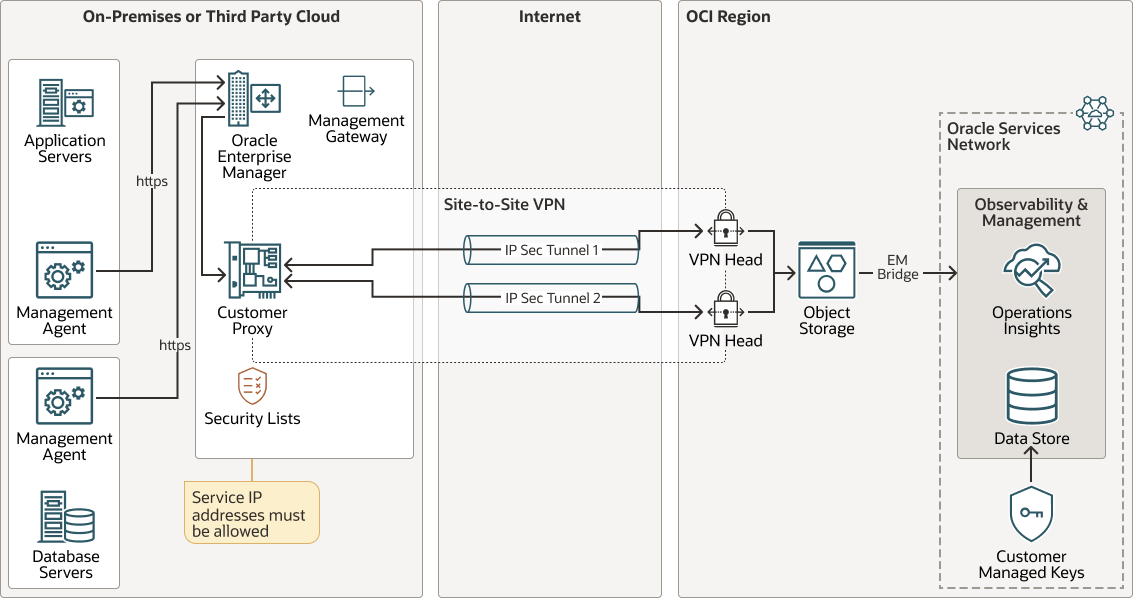Uncover Performance Issues, Forecast Consumption, and Plan Capacity with OCI Ops Insights
Prevalent models for Observability and Management services lack features that provide holistic insights into infrastructure and database investments that can reduce costs of operations by using machine-learning-based and data-driven capacity planning, and that can perform proactive performance management and improve application throughput by tracking trending enterprise SQL running performance.
This reference architecture describes the process to use Oracle Cloud Infrastructure Operations Insights (OCI Ops Insights) to perform resource analysis against databases and hosts, including Exadata systems managed by Oracle Enterprise Manager. Oracle Enterprise Manager lets you transfer data from Oracle Enterprise Manager targets and Oracle Management Repository (OMR) to an OCI Object Storage bucket, where it is easily accessed by OCI Ops Insights.
Data transfer from Oracle Enterprise Manager to OCI Ops Insights is configured in two steps:
- Set up target-level data transfer from Oracle Enterprise Manager to OCI Object Storage.
- Set up data transfer from OCI Object Storage to OCI Ops Insights.
Each step involves setting up a data transfer bridge. There are two bridges involved in the Oracle Enterprise Manager to OCI Ops Insights communication:
- An Oracle Enterprise Manager Cloud Bridge to move target-level data from Oracle Enterprise Manager to the OCI Object Storage bucket.
- An OCI Ops Insights EM Bridge to move data from the OCI Object Storage bucket to OCI Ops Insights for analysis.
System prerequisites:
- OCI Object Storage 13c Release 5 Update 13 (13.5.0.13) or above
- OCI Object Storage Agents must be on 13c Release 13 (13.5.0.13) or above
- Database Plug-in version 13.5.0.13 or above
Once the Oracle Enterprise Manager to OCI Ops Insights connectivity is set up, your target data is automatically uploaded at frequent intervals to the OCI Object Storage bucket so that OCI Ops Insights is always working with the most recent target data.
The following graphic illustrates how target data flows from Oracle Enterprise Manager to OCI Ops Insights once the configuration process has been completed. The right side is the portion of the setup you will perform for Oracle Enterprise Manager.
Architecture
This architecture describes the process to use OCI Ops Insights to perform resource analysis against databases and hosts, including Exadata systems managed by Oracle Enterprise Manager. Use this architecture for retaining and analyzing longer-term telemetry to provide insights on future resource demand and application performance.
Configuring OCI service connectivity requires setup of both Oracle Enterprise Manager and the OCI service, and is performed in two steps:
- Export Oracle Enterprise Manager data to OCI.
- Import data from the OCI Object Storage bucket to the OCI service.
To move target data from Oracle Enterprise Manager to OCI, you create a Cloud Bridge in Oracle Enterprise Manager. The Cloud Bridge defines a data connection to the OCI Object Storage bucket residing in OCI. Bridge creation is a one-time setup. Once created, it can be edited, updated, or deleted as needed. Install EM Agent on application and database servers for Oracle Enterprise Manager to fetch data from these servers. After installing EM Agent on these servers, these databases need to be discovered in Oracle Enterprise Manager.
Once you've set up the Cloud Bridge to move data from Oracle Enterprise Manager to the OCI Object Storage bucket, you will need to create an EM Bridge in OCI to move Oracle Enterprise Manager target data from the OCI Object Storage bucket to OCI Ops Insights for processing.
When selecting the OCI service while enabling data export, select the appropriate OCI Ops Insights service for your needs:
- Capacity planning and SQL warehouse
For Exadata Insights, Host Capacity Planning, Database Capacity Planning, SQL Warehouse, and SQL Explorer.
- EM Warehouse
The Oracle Enterprise Manager repository contains critical information such as operational, performance and configuration metrics, and target inventory data for the targets monitored by Oracle Enterprise Manager. EM Warehouse provides a convenient way to access and analyze this data using cloud-based tools and services.
- Exadata Warehouse
Exadata Warehouse provides a store-based custom analytics solution that helps maximize the performance and utilization of critical workloads running on all Exadata deployments that are monitored by EM 13.5 RU10 or later.
Before setting up the EM Bridge, you need to create Oracle Identity and Access Management (IAM) policies in order to read from the configured OCI Object Storage bucket. Create a dynamic group and provide permissions for the dynamic group to access the data in the above OCI Object Storage compartment.
Reference architecture using Oracle Enterprise Manager Agents
This reference architecture illustrates the on-premises or third-party cloud setup of Oracle Enterprise Manager Agents on target application or database servers. Oracle Management Agent is one of the core components of Oracle Enterprise Manager Cloud Control (Cloud Control) that enables you to convert an un-managed host to a managed host in the Oracle Enterprise Manager system. Oracle Management Agent works in conjunction with the plug-ins to monitor the targets running on that managed host. Oracle Management Agent posts the data to OCI via the proxy or a firewall. The agent is responsible for collecting log, metrics, performance, configuration, orchestration jobs, and compliance checks to be used in the various services (for example, log analytics, IT analytics, infrastructure monitoring, configuration, and compliance).
Note:
Starting with Oracle Enterprise Manager Cloud Control 13c Release 5 Update 15 (13.5.0.15), Cloud Bridge supports the specification of proxy details which are used for outbound connections to OCI. This release update (patch) needs to be applied to the OMS, central agent, and all other participating agents.The following diagram illustrates this reference architecture.
oracle-enterprise-manager-agents-oracle.zip
Reference architecture with routing via Enterprise Manager
This reference architecture illustrates how to transport your Oracle Cloud Observability and Management Platform data, collected on-premises or in a third-party cloud network. Oracle Enterprise Manager Cloud Control agents route all the traffic to the Management Gateway and from there is gets routed to OCI via the proxy. Using the Management Gateway as the single point for traffic to and from OCI means that the enterprise firewall only needs to allow HTTPS communication from the host where the Management Gateway resides. The Management Gateway can reside in the EM OMS or on a separate host.
All communication from Management Agent Gateway to Oracle Cloud is over HTTPS (port 443) and is outbound only.
The following diagram illustrates this reference architecture.
routing-enterprise-manager-oracle.zip
The architecture has the following components:
- Region
An Oracle Cloud Infrastructure region is a localized geographic area that contains one or more data centers, called availability domains. Regions are independent of other regions, and vast distances can separate them (across countries or even continents).
- Virtual cloud network (VCN) and subnets
A VCN is a customizable, software-defined network that you set up in an Oracle Cloud Infrastructure region. Like traditional data center networks, VCNs give you complete control over your network environment. A VCN can have multiple non-overlapping CIDR blocks that you can change after you create the VCN. You can segment a VCN into subnets, which can be scoped to a region or to an availability domain. Each subnet consists of a contiguous range of addresses that don't overlap with the other subnets in the VCN. You can change the size of a subnet after creation. A subnet can be public or private.
- VCN attachments
You can attach multiple VCNs to a single DRG. Each VCN can be in the same tenancy as the DRG, or they can be in different tenancies.
- Route table
Virtual route tables contain rules to route traffic from subnets to destinations outside a VCN, typically through gateways.
- Security list
For each subnet, you can create security rules that specify the source, destination, and type of traffic that must be allowed in and out of the subnet.
- Site-to-Site VPN
Site-to-Site VPN provides IPSec VPN connectivity between your on-premises network and VCNs in Oracle Cloud Infrastructure. The IPSec protocol suite encrypts IP traffic before the packets are transferred from the source to the destination and decrypts the traffic when it arrives.
- Management Gateway
Management Gateway provides a single egress point for management agents and other clients to connect to OCI services.
- Oracle Enterprise Manager Management Agent
Oracle Enterprise Manager (OEM) Management Agent is a software component that monitors targets running on hosts and communicates that information to the middle-tier Oracle Management Service (OMS). The Management Agent is an integral software component that enables you to convert an un-managed host to a managed host in the Oracle Enterprise Manager system. The Management Agent works in conjunction with the plug-ins to monitor the targets running on that managed host.
- Oracle Management Service
Oracle Management Service (OMS) is a web-based application that orchestrates with the Management Agents and the plug-ins to discover targets, monitor and manage them, and store the collected information in a repository for future reference and analysis. The OMS also renders the user interface for Oracle Enterprise Manager Cloud Control.
- Central Agent
With the first Oracle Management Service (OMS) you install, by default you receive a Management Agent called the Central Agent. The Central Agent is used for monitoring only the first OMS host, the first OMS, and the other targets running on the first OMS host. To monitor other hosts and the targets running on those hosts, you must install a separate standalone Management Agent on each of those hosts.
- Operations Insights
Oracle Cloud Infrastructure Operations Insights enables administrators to uncover performance issues, forecast consumption, and plan capacity using machine-learning-based analytics on historical and SQL data. Organizations can use these capabilities to make data-driven decisions to optimize resource use, proactively avoid outages, and improve performance.
Considerations
When implementing this reference architecture, consider these options.
- Cost
Management Gateway, Management Agent, VCNs, subnets, DRGs, security lists, and route tables have no additional cost. The test virtual machine (VM) in the deployment can use the Free Tier shape.
- Availability and redundancy
- Management Gateway HA supports deployment behind load balancers.
- DRGs are redundant and fail over automatically.
- Each connection can have multiple tunnels.
- Consider using multiple internet links from different providers on production environments.
Explore More
Learn more about OCI Ops Insights.
Review these additional resources:
- Best Practices Framework for Oracle Cloud Infrastructure
- Operations Insights Documentation
- Integrating Enterprise Manager with OCI Services
- Export Enterprise Manager Data to OCI
- Secure on-premises observability data upload using Management Gateway
- Site-to-Site VPN
- Oracle Cloud Infrastructure Documentation
- Oracle Cloud Cost Estimator
Video series:


